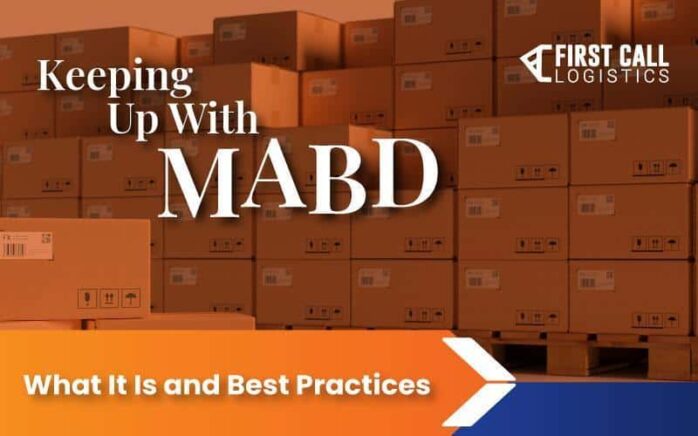Keeping Up With MABD: What It Is and Best Practices

Moving freight to its ultimate destination on time is about more than just hitting a due date. In logistics, we stake a lot of our reputation on consistent, timely deliveries – and in many cases, arriving late might even mean useless or spoiled product. Additionally, many companies charge a fee (sometimes a significant percentage) for late products, which means shipping companies are under immense pressure to move products across the country in a timely manner, no matter the circumstances.
What is Must Arrive by Date, or MABD?
The aptly-named Must Arrive By Date, or MABD, is the day by which products must arrive at their destination. Most distribution centers or facilities dictate a MABD Window, which is the day freight is due plus the three previous dates. This means being ahead of the game by too much time can be a problem; if trucks arrive outside of the MABD window, too early or too late, the supplier must pay a percentage of the freight’s cost.
What is the purpose of MABD?
MABD windows guide both the shipper and the facility receiving the shipment. For shippers, it gives a clear target for delivery with some slight wiggle room in the event of a delay. For the facilities, on time delivery is essential in order to meet consumer demands and provide fresh, healthy foods where applicable. Developing a reputation for reliable on time delivery can give good shippers an edge in the market.
Now more than ever, distributors are using MABD to help reduce clutter and cost. Retail giants like Walmart and Target are already moving away from the traditional warehouse model of keeping extra inventory on hand somewhere in the back of the store – moving merchandise from a truck immediately onto the floor helps prevent waste and meet consumer demands. Still, retailers can lose big if their stores aren’t fully stocked; around two to three percent of expected total sales are lost to out-of-stock items. Enforcing the MABD window helps minimize that cost.
The Differences Between OTIF and MABD
While MABD is a label used to ensure product arrives at a facility by a certain date, “on-time, in-full” (or OTIF) is a scoring system many facilities use to rate shippers and other suppliers. Some distribution centers (or DCs) calculate the OTIF as the percentage of product that is delivered within the MABD. There are some exceptions to this rule (such as Walmart’s exception of purchase orders for important merchandise or direct-to-store deliveries).
Challenges that Come with MABD
The biggest challenge for suppliers is keeping track of and hitting every MABD window for each of their shipping partners. For clients with a tight MABD window, the likelihood of a late delivery increases. Likewise, any supplier using a third party to ship goods that fill less than a truckload (LTL) also raises the possibility of a late delivery.
By shipping full truckloads to retailers (and only one MABD to keep track of), it’s easier to track when and where goods are traveling. If trucks deliver to more than one retailer in a day, a delay at one can quickly cause a chain reaction down the line of further deliveries.
Staying Within the MABD Window
In general, MABD compliance pertains to all items arriving at their destination within the MABD window with at least 90 percent of the goods received. It’s important for shipping and delivery companies to stay within the MABD window to maintain their supplier-retailer relationships; retailers will always prefer suppliers that prove themselves consistently on time and dependable. Receiving a high OTIF score increases the chances of a retailer choosing that supplier again. Noncompliance predictably results in penalties, which is often a significant percentage of the cost of delivery.
Strategies to Avoid Fees
There are several tips and tricks to avoid being hit with a fee including:
- Using an experienced supply chain management company.
- Avoiding LTL shipping when possible.
- Evaluating multiple third-party logistics suppliers before committing to a contract.
- Ensuring all drivers understand the MABD of the retailer they are delivering to.
- Planning for delays.
- Aiming to deliver on the first day of the MABD window.
Walmart’s Influence on MABD and OTIF Standards
In today’s competitive market, big-box retailers are always looking for ways to streamline inventory costs while keeping products readily available on shelves. To strike that balance, these retailers are following Walmart’s footsteps and tightening their MABD and OTIF expectations.
To hold suppliers accountable, Walmart has implemented a fee of three percent of the cost of goods on every one of their non-compliant deliveries. The time of delivery is not the only important factor, but also the completion and state of products upon delivery.
Conclusion
As delivery schedules tighten and increasing demands are placed on the global supply chain, suppliers will continue to be tasked with ambitious MABD windows. The good news? It’s all doable – tracking shipments, planning ahead and giving drivers the tools they need to deliver on time not only improves the reputation of suppliers, but allows them the opportunity to move more goods.
Simplify your Next Shipment with First Call Logistics
Building and managing cost-efficient supply chains is a full-time job. First Call’s rare combination of in-house assets, expert problem-solving and track record of stellar customer service makes us the 3PL of choice for business partners with a wide range of shipping needs.
More Resources for FCL Shippers:
- Article: The Importance of On-Time In-Full (OTIF) Delivery
- Article: 20 Essential Supply Chain KPIs for Your Business to Track
- Article: Four Supply Chain Challenges Facing Retailers
- Article: 5 Logistical Challenges Facing the Food and Beverage Industry
- Article: How to Identify Weak Points in Your Supply Chain
- Article: How 3PLs Serve the Seven R’s of Logistics
Get the latest supply chain news and updates directly to your inbox.